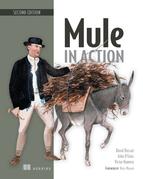Table of Contents
1.1. Enterprise Integration Patterns and service-oriented architecture
1.5. Running, testing, and deploying the application
1.5.1. Running the application
Chapter 2. Processing messages with Mule
2.2. Interacting with messages
2.3. Exploring the Mule message
2.4. Speaking the Mule Expression Language
Chapter 3. Working with connectors
3.4.1. Sending JMS messages with the JMS outbound endpoint
3.4.2. Receiving JMS messages with the JMS inbound endpoint
3.7.1. Using a JDBC inbound endpoint to perform queries
3.9. Using the Twitter cloud connector
Chapter 4. Transforming data with Mule
4.1. Working with transformers
4.3.3. Modifying properties, flow variables, and session variables
4.5. Transforming JSON with Mule
Chapter 5. Routing data with Mule
5.1. Deciding how to route a message
5.2.1. Filtering by payload type and header
5.2.3. Filtering with expressions
5.3. Routing to multiple recipients
5.3.1. Dispatching messages with the all router
5.4. Routing and processing groups of messages
Chapter 6. Working with components and patterns
6.1.1. Executing business logic
6.1.2. Resolving the entry point
6.1.3. Configuring the component
6.2. Simplifying configuration with configuration patterns
Chapter 7. Integration architecture with Mule
7.1. Structuring integration applications
7.1.1. Guerrilla SOA with hub and spoke
7.2. Mule implementation patterns
7.2.1. Using a canonical data model
8.1. Deploying standalone Mule applications
8.1.1. Packaging a standalone Mule app
8.1.2. Deploying applications to Mule
8.2. Deploying Mule to a web container
8.3. Deploying applications to CloudHub
8.4. Embedding Mule into an existing application
8.5. Deploying Mule for high availability
Chapter 9. Exception handling and transaction management with Mule
9.1.1. Using reconnection strategies
9.2. Using transactions with Mule
9.2.1. Single-resource transaction
10.1. Spring Security 3.0 and Mule
10.1.1. User security with an in-memory user service
10.4. Message encryption with Mule
11.1. Staged event-driven architecture
11.2. Understanding thread pools and processing strategies
11.2.1. Processing strategies and synchronicity
11.3. Identifying performance bottlenecks
3. Traveling further with Mule
Chapter 12. Developing with Mule
12.1. Understanding the Mule context
12.2.1. Reaching a local Mule application
Chapter 13. Writing custom cloud connectors and processors
13.1. Simplifying Mule development with the DevKit
13.2. Introduction to authoring cloud connectors
13.2.1. Rendering extensions configurable
13.2.3. Creating message processors
13.2.4. Creating intercepting message processors
13.2.5. Creating simple REST consumers
Chapter 14. Augmenting Mule with orthogonal technologies
14.1. Augmenting Mule flows with business process management
14.2. Complex event processing
14.3. Using a rules engine with Mule
Appendix A. Mule Expression Language
Appendix B. Component and transformer annotations quick reference
Appendix C. Mule Enterprise Edition
Appendix D. A sample Mule application
